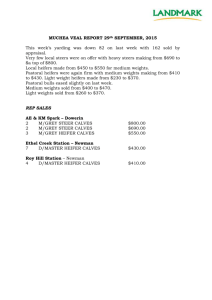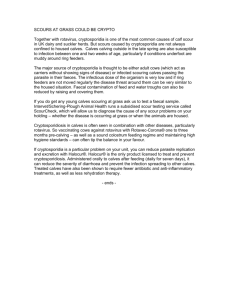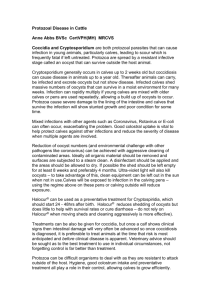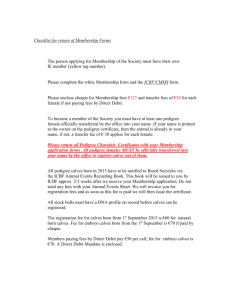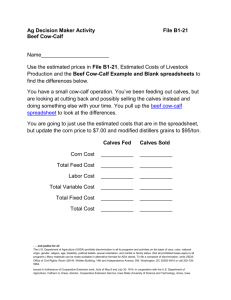the effect of chromium supplementation on some metabolic and
advertisement
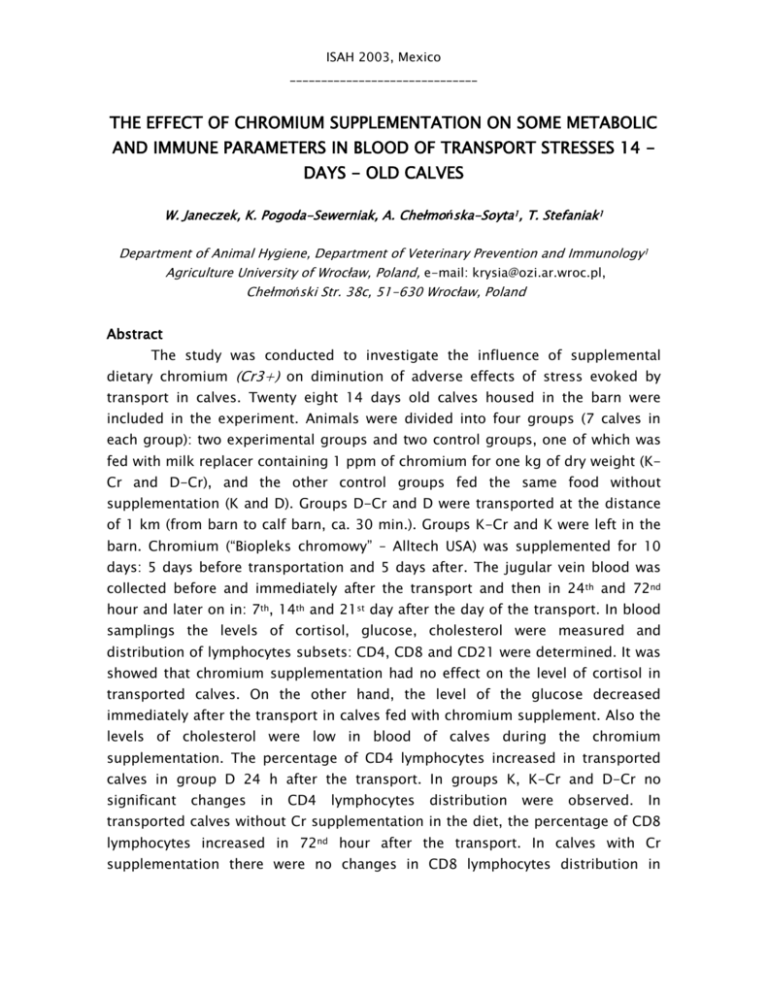
ISAH 2003, Mexico ______________________________ THE EFFECT OF CHROMIUM SUPPLEMENTATION ON SOME METABOLIC AND IMMUNE PARAMETERS IN BLOOD OF TRANSPORT STRESSES 14 DAYS - OLD CALVES W. Janeczek, K. Pogoda-Sewerniak, A. Chełmońska-Soyta1, T. Stefaniak1 Department of Animal Hygiene, Department of Veterinary Prevention and Immunology1 Agriculture University of Wrocław, Poland, e-mail: krysia@ozi.ar.wroc.pl, Chełmoński Str. 38c, 51-630 Wrocław, Poland Abstract The study was conducted to investigate the influence of supplemental dietary chromium (Cr3+) on diminution of adverse effects of stress evoked by transport in calves. Twenty eight 14 days old calves housed in the barn were included in the experiment. Animals were divided into four groups (7 calves in each group): two experimental groups and two control groups, one of which was fed with milk replacer containing 1 ppm of chromium for one kg of dry weight (KCr and D-Cr), and the other control groups fed the same food without supplementation (K and D). Groups D-Cr and D were transported at the distance of 1 km (from barn to calf barn, ca. 30 min.). Groups K-Cr and K were left in the barn. Chromium (“Biopleks chromowy” – Alltech USA) was supplemented for 10 days: 5 days before transportation and 5 days after. The jugular vein blood was collected before and immediately after the transport and then in 24th and 72nd hour and later on in: 7th, 14th and 21st day after the day of the transport. In blood samplings the levels of cortisol, glucose, cholesterol were measured and distribution of lymphocytes subsets: CD4, CD8 and CD21 were determined. It was showed that chromium supplementation had no effect on the level of cortisol in transported calves. On the other hand, the level of the glucose decreased immediately after the transport in calves fed with chromium supplement. Also the levels of cholesterol were low in blood of calves during the chromium supplementation. The percentage of CD4 lymphocytes increased in transported calves in group D 24 h after the transport. In groups K, K-Cr and D-Cr no significant changes in CD4 lymphocytes distribution were observed. In transported calves without Cr supplementation in the diet, the percentage of CD8 lymphocytes increased in 72nd hour after the transport. In calves with Cr supplementation there were no changes in CD8 lymphocytes distribution in ISAH 2003, Mexico ______________________________ comparison with calves that werent transported. In group D and K the increase in percentage of CD21 lymphocytes was observed after the transport. Presented data showed how the Cr supplementation modulated the metabolic and immune response evoked by elevated level of cortisol in stressed calves. INTRODUCTION Calves mortality and morbidity caused by respiratory and digestive tract diseases are important problem in intensively managed cattle production. Intensity and frequency of these diseases are markedly influenced by stress inducing management practices applied during the first few months of calves life. Among them weaning, isolation, transport, commingling and exposition to new antigens are the most common. Simultaneously decreasing of lactogenic immunity increases susceptibility of animals to infectious diseases caused by opportunistic microorganisms. Improving of immune response (immunocompetance) of young animals by using of immunomodulatory agents is one of the way of reducing and prevention of calves losses. Trivalent chromium naturally occurs as compound of Cr(III) and nicotine acid stabilized by some amino acids, chromium picolinate or inorganic trivalent chromium ware showed as potent immunomodulator in humans and farm animals [1, 5, 6, 8]. It was noticed also by Burton [7], Barton at al [5]. And Chang et al. [8, 9] that food supplementation with organic and inorganic trivalent chromium improved performance and immune status of stressed feeder calves. Furthermore, involvement of chromium in metabolism of glucose, lipids and cholesterol is indicated as beneficial for growth and health status of food producing animals [3, 11]. The aim of the study was to investigate the influence of supplemental dietary chromium on diminution of adverse effects of transport-induced stress in calves. MATERIALS AND METHOD Twenty eight crossbred black and white (25%) + fresian holstain (75%) 14 days old calves were used in the experiment. Animals were fed whole milk and milk replacer (Mlekotek R 266). Calves were randomly assigned to four groups (7 calves in each group): group K – calves stayed in the barn (in the place of birth), fed a milk diet without chromium supplementation, group K-Cr – calves stayed in the barn (in the place of birth), fed a milk diet with chromium supplementation, group D - calves transported to calf pen for 30 minutes, fed a milk diet without ISAH 2003, Mexico ______________________________ chromium supplementation, group D-Cr- calves transported to calf pen for 30 minutes, fed a milk diet with chromium supplementation. Calves from group K-Cr and D-Cr were fed a milk supplemented 1 ppm of Cr per kg of dry matter for 10 days (5 days before and 5 days after transport). Chromium was supplied from “biopleks chromu” (Alltech USA). Blood, via jugular venipuncture, was collected from calves 5 days before transport and then on the day of transport immediately before and after transport and then 24 and 72 hours and on day 7,14 and 21 after transport. At the same time blood was sampled from calves which remained in the barn (group K and K-Cr) at intervals. Samples of sera were analyzed for the level of cortisol (RIA method), glucose and cholesterol (enzymatic method). Subsets of lymphocytes CD4, CD8 and CD21 were analyzed by flow cytometry analysis (FACS Calibur, Becton Dickinson). RESULTS AND DISCUSSION Serum cortisol level increased in both transported groups of calves (i.e. D and D-Cr) immediately after transport (p0,01) and then decreased within 24 hours (p0,01). The highest level of cortisol equal to 14,57ng/ml was observed in group D. Cortisol level remained stable in group K and K-Cr, although in group KCr insignificant increasing of its level was observed during time of transport of calves from group D-Cr (Table 1). It was showed that chromium reduced cortisol level in stressed feeder calves [8, 9, 15, 16]. In our experiment we did not observe the lowering of serum cortisol level associated with Cr supplementation. However, in groups D-Cr and K-Cr we observed significant decreasing of glucose concentration after the transport. The level of glucose increased in both groups of calves within 24 hours after the transport, in group K-Cr it was significantly higher in comparison wth group D-Cr (Table 2). Similar observations were showed by Baldi et al. [2] in weaning-stressed piglets where Cr supplementation did not reduce stress (cortisol level) but improved peripheral glucose utilisation. It was shown that chromium as a component of glucose tolerance factor (GTF) facilitated interaction between insulin and insulin receptors and improved glucose transport into the cells [10, 11, 12]. On the other hand, cortisol inhibits peripheral utilization of glucose. Thus, it seems that chromium supplementation supported glucose metabolism at periphery in examined calves under stress conditions. There were no significant differences in glucose concentration in serum of calves from groups K and D. ISAH 2003, Mexico ______________________________ In the beginning of the experiment cholesterol concentration in group K and D (without chromium supplementation) and K-Cr and D-Cr (with chromium supplementation) was differentiated. However, in group D significant increase of the cholesterol level was observed on the day of the transport. In group K the level of this agent systematically increased till the end of the experiment. On the other hand in both groups supplemented with chromium the cholesterol concentration remained unchanged till 72nd hour after the transport (Table 3). Stable and considerably low level of cholesterol in groups K-Cr and D-Cr may be attributed to Cr supplementation as was showed in other experiments carried on calves and sheep and pigs [4, 13, 17]. Marked differences in percentage of lymphocytes subpopulations among individual animals and examined groups of calves were observed. However, in group D and K (without Cr supplementation) we observed marked differences in lymphocytes distribution which followed transport: the percentage of CD4 lymphocytes in group D increased significantly (p0,01) 24 hours after transport (Table 4), CD8 lymphocytes subpopulation decreased on the day of transport and increased 72 hours later (Table 5). The percentage of CD21 lymphocytes increased 24 hours in D groups and 72 hours in K groups after transport (Table 6). Contrary to these observations in group of calves supplemented with Cr, no marked changes in lymphocytes subpopulations distribution were observed as a result of transportation. Although, it is generally accepted that stress inhibits immune response, it was also observed that in rats mild shocks with handling caused significantly increased immune reactions (IL-2 synthesis, PHA proliferative response, NK cells activity) [14]. Therefore we may conclude that half an hour transport is rather moderate stressor in the context of lymphocytes subpopulation distribution. Under these conditions Cr supplementation restrained increasing of CD4, CD8 and CD21 lymphocytes subpopulations in blood. In conclusion it may be stated that Cr supplementation is beneficial for stressed calves as we consider modulation of immune response and peripheral glucose utilization. Table 1. Mean concentrations of cortisol (ng/ml) in serum of 14 days old calves. Sampling Group of calves direct before direct after 24 h after 72 h after transport transport transport transport ISAH 2003, Mexico ______________________________ D 4,542,79 14,578,61 1,812,34 1,430,81 K 6,062,77 5,034,72 4,002,48 2,141,21 D-Cr 3,072,99 12,284,67 3,572,00 4,172,71 K-Cr 2,231,43 5,062,24 1,400,65 2,772,32 Table 2. Mean concentrations of glucose (mmol/l) in serum of 14 days old calves. Sampling Group direct 72 h of 5 days direct after 24 h after 1week 2 weeks 3 weeks calves before before transpor after transpor after after after transport transport t transport t transport transport transport D 5,640,76 5,460,87 3,580,7 4,480,2 4,700,7 4,970,78 4,290,83 4,570,70 K 5,720,78 5,850,97 5,140,57 5,350,76 5,090,87 D-Cr 4,890,70 5,010,73 4,140,9 6,031,2 5,721,3 4,910,66 4,320,39 4,710,82 K-Cr 5,350,81 4,781,12 5,620,89 5,141,2 5,221,0 5,750,8 7 9 6 6,081,0 5,921,4 5,631,2 0 1 6 7 8 9 3 1 9 5,891,24 5,421,34 Table 3. Mean concentrations of cholesterol (mg/dl) in serum of 14 days old calves. Sampling Group of calves 5 days direct direct 24 h 72 h 7 days 14 days 21 days before before after after after after after after Transpor transpor transport transport transport D K D-Cr K-Cr t t transport transport transport X 91,71 148,44 133,54 110,44 112,26 105,60 97,03 101,64 S 32,02 55,14 19,38 33,19 16,58 53,94 15,68 36,46 X 81,21 92,57 107,42 102,09 107,60 121,04 133,07 174,37 S 27,24 36,40 37,06 48,46 44,86 31,66 39,37 31,25 X 60,13 62,37 63,22 66,11 78,82 90,23 80,82 72,16 S 22,47 23,11 15,42 20,07 19,12 22,53 16,46 15,15 X 58,85 56,16 56,00 67,63 77,40 109,26 134,31 123,23 S 15,71 16,67 17,61 13,88 19,58 18,60 22,65 12,33 Table 4. Mean percentage of lymphocytes CD4 in blood of 14 days old calves ISAH 2003, Mexico ______________________________ Sampling Group of 5 days direct direct Caves before before after transport transport 24 h after 72 h after 34,0612,2 0 K nd D-Cr K-Cr 14 days after after 2 days after transport transport transport transport transport 30,9315,0 D 7 days 8 34,2915,08 27,226,64 transport 29,096,75 48,4621,6 41,5617,4 29,5815,0 8 4 8 19,988,13 21,634,39 27,066,40 12,1711,7 29,613,49 29,613,49 16,2210,0 21,5011,59 25,4411,06 13,798,66 7,256,77 0 11,087,53 10,364,92 6 6,483,73 13,535,72 13,477,53 14,358,54 14,957,64 9,419,32 14,467,44 12,9810,83 8,176,07 15,539,77 nd – not determined Table 5. Mean percentage of lymphocytes CD8 in blood of 14 days old calves Group Sampling of calves 5 days before direct before direct after 24 h aftrer 72 h aftrer 7 days after 14 days after 21 days after transport D K D-Cr K-Cr transport transport transport transport transport transport 20,348,16 20,678,24 16,2210,04 16,967,06 26,1813,83 15,759,04 9,312,42 nd 10,255,63 10,757,47 11,192,92 10,655,60 7,183,86 10,185,83 15,599,27 15,985,63 12,023,54 11,421,94 11,436,39 10,652,50 10,454,47 13,835,33 10,123,02 9,873,47 transport 7,601,89 8,653,05 6,143,02 5,925,31 4,200,93 7,181,23 9,502,11 11,662,98 nd – not determined Table 6. Mean percentage of lymphocytes CD21 in blood of 14 days old calves Group Sampling of calves 5 days before direct before direct after transport D K transport 72 h after 7 days after 14 days after 21 days after transport transport transport transport 11,655,91 12,135,35 13,438,82 20,1418,72 19,818,09 12,607,11 7,201,64 6,061,26 nd transport 24 h after transport 12,0311,7 12,1911,15 10,775,41 25,2814,10 6,702,82 8,352,74 11,878,31 D-Cr 15,6310,65 13,668,65 15,359,78 14,938,62 14,479,30 12,628,91 11,215,42 17,5412,08 K-Cr 11,936,77 11,767,58 10,566,08 11,695,10 10,244,43 12,606,27 17,147,24 15,619,41 nd – not determined ISAH 2003, Mexico ______________________________ REFERENCES 1. Anderson R.A. Stress effects on chromium nutrition of humans and farm animals. Biotechnology in the feed industry: Proc. Alltech’s Tenth Ann. Symp. [ed: Lyons T.P., Jacques K.A.]. 1994, 267-274; Loughborough, UK; Nottingham University Press. 2. Baldi A., Bontempo V., DellOrto V., Cheli F., Fantuz F., Savoni G.: Effects of dietary chromium-yeast in weaning-stressed piglets. Can. J. Anim. Sci. 1999, 79(3), 369-373. 3. Borgs P, Mallard BA.: Immune-endocrine interactions in agricultural species: chromium and its effect on health and performance. Domest Anim Endocrinol 1998,15(5), 431438. 4. Bunting L.D., Fernandez J.M., Thompson D.L.Jr, Southern L.l.: Influence of chromium piclinate on glucose usage and metabolic criteria in growing Holstein calves. J.Anim.Sci. 1994, 72(6), 1591-1599. 5. Burton J.L., Mallard B.A., Mowat D.N.: Effect of supplemental chromium on immune response of periparturient and early lactation dairy cows. J.Anim.Sci. 1993, 71, 6, 1532-1539. 6. Burton J.L., Nonnecke B.J., Elsasser T.H., Mallard B.A., Yang W.Z., Mowat D.N.: Immunomodulatory activity of blood serum from chromium-supplemented periparturient dairy cows. Vet. Immunol. Immunopathol. 1995, 49, 1-2, 29-38. 7. Burton J.L.: Supplemental chromium: its benefits to the bovine immune system. Anim. Fed Sci.Technol. 1995, 53, 2, 117-133. 8. Chang X., Mowat D.N., Mallard B.A.: Supplemental chromium and niacin for stressed feeder calves. Can.J.Anim.Sci. 1995, 75, 3, 351-358. 9. Chang X., Mowat D.N.: Supplemental chromium for stressed and growing feeder calves. J.Anim.Sci. 1992, 70, 2, 559-565. 10. Davis C. M., Royer A., Vincent J.B.: Synthetic Multinuclear Chromium Assembly Activates Insulin Receptor Kinase Activity: Functional Model for Low-Molecular-Weight Chromium-Binding Substance. Inorg. Chem. 1997, 36, 5316-5320. 11. Gałuszka G., Cieślak-Golonka M.: Around the biological importance of chromium (pol.) Wiadomości Chemiczne. 1999, 53, 5-6, 279-399. 12. Grela Ugeniusz R., Studziński T., Rabos A.: Role of chromium in human and animal nutrition. (pol). Med. Wet. 1997, 53 (6), 312-315. 13. Lien T.F., Wu C.P., Wang B.J., Shaio M.s., Shiao T.Y., Lin B.H., Lu J.J., Hu C.Y.: Effect of supplemental levels of chromium picolinate on the growth performance, serum traits and carcass characteristics and lipid metabolism of growing pigs. Anim. Sci. 2001, 72(2), 289-296. 14. McEwen, Bruces S., Biron Christine A., Brunson Kenneth W., Bulloch K., Chambers W.H et al.: The role of adrenocorticoids as modulators of immune function in health and disease: neural, endocrine and immune interactions. Brain Res. Rev. 1997, 23, 79-133. ISAH 2003, Mexico ______________________________ 15. Moonsie-Shageer S, Mowat D.N.: Effect of level supplemental chromium on performance, serum constituens, and immune status of stressed calves. 1993. J. Anim. Sci. 71, 232-238. 16. Mowat D.N., Chang X., Yang W.Z.: Chelated chromium for stressed feeder calves. 1993, Can. J. Anim. Sci. 73, 49. 17. Uyanik F.: The effects of dietary chromium supplementation on same blood parameters in sheep. Biol. Trace Element Reserch. 2001, 84, 1-3, 92-102.

